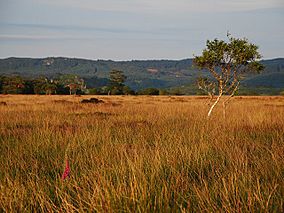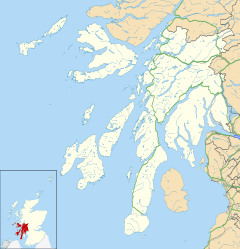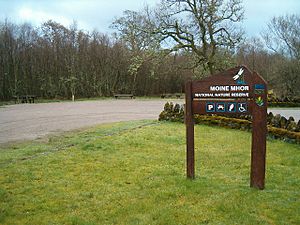Moine Mhòr facts for kids
Quick facts for kids Moine Mhòr National Nature Reserve |
|
|---|---|
|
IUCN Category IV (Habitat/Species Management Area)
|
|

Evening view across the Moine Mhòr
|
|
| Location | Argyll and Bute, Scotland |
| Area | 492.5 ha (1,217 acres) |
| Established | 1987 |
| Governing body | NatureScot |
| Moine Mhòr National Nature Reserve | |
Moine Mhòr means "Great Moss" in Scottish Gaelic. It is a huge area of raised bog in Argyll and Bute, Scotland. This special place is part of the Kilmartin Glen area.
Moine Mhòr has many different natural areas. You can find raised bogs, saltmarshes, wet grasslands, and woodlands. There are also areas called alder carr and fen. All these different places make great homes for many kinds of animals and plants.
In 1987, Moine Mhòr became a National Nature Reserve (NNR). This means it is a protected area. NatureScot now owns and looks after it. NatureScot says that lowland raised bogs, like Moine Mhòr, are very rare. They are also among the most threatened natural places in Europe. This is because people have removed peat, planted too many trees, or changed the land for farming.
About 8,000 people visit Moine Mhòr NNR each year. It is a popular spot for local people and school groups. Tourists visiting nearby Kilmartin Glen and the Crinan Canal also enjoy it. There is a 600-meter nature trail at the north side of the reserve. Visitors can also use a car park and a picnic area.
Contents
The History of Moine Mhòr
How the Bog Formed
Moine Mhòr started to form about 10,000 years ago. This was after the last Ice Age ended. At first, rising sea levels covered the area with a type of clay. This clay does not let water through.
As the glaciers melted, the land slowly began to rise. This is called post-glacial rebound. A shallow estuary, which is where a river meets the sea, formed at the mouth of the River Add. Later, a freshwater loch (lake) formed over Moine Mhòr. It was separated from the sea by a saltmarsh.
About 5,500 years ago, sea levels dropped even more. Then, sphagnum mosses started to grow in the area. The clay underneath kept the ground very wet. Over a long time, layers of peat built up. This is how Moine Mhòr became the raised bog we see today.
People and the Bog
Moine Mhòr is west of Kilmartin Glen. This glen is famous for its ancient history. But the boggy ground meant that ancient people could not live or farm directly on the moss.
However, they likely used the bog for other things. They probably cut peat for fuel to burn. They also collected berries and lichens. These could be used for food, drinks, dyes, and even medicines. Scientists have studied core samples from the bog. These show that the bog was often burned. This helped keep the land open for animals to graze.
The Crinan Canal was built just south of Moine Mhòr. It was built between 1794 and 1801. After the canal, people started using coal from Glasgow for fuel. This meant they cut less peat from the bog. Landowners then tried to "reclaim" the bog. They drained it to make it suitable for farming.
Controlled burning of the bog continued. But the reason changed. Instead of grazing, people wanted to encourage red grouse for hunting parties. Around 1980, about 100 hectares of conifer trees were planted at Moine Mhòr.
Protecting the Bog
To stop more of the bog from disappearing, the Nature Conservancy Council (NCC) stepped in. The NCC was the group before NatureScot. They decided to buy about 500 hectares of land. They then declared the area a national nature reserve.
Since taking over, NatureScot has worked to fix the damage from past drainage. They have built over 190 dams in the drainage ditches by 2017. This has helped the water level rise in the bog. This higher water level allows the sphagnum mosses to grow back. NatureScot has also removed trees and bushes. This helps keep the area as a healthy raised bog.
Plants and Animals of Moine Mhòr
Amazing Plants
Sphagnum mosses are super important for a raised bog. They are the main plants that help the bog grow. Nine different types of sphagnum moss have been found at Moine Mhòr NNR.
The edges of the bog have many different flowering plants. These include the beautiful purple heath orchid and the round-leaved sundew. The sundew is a cool plant that eats insects! You can also find bog myrtle and bog asphodel.
Insects and Butterflies
The plants in the bog support many kinds of small creatures called invertebrates. One special butterfly here is the marsh fritillary. This is one of Europe’s most threatened butterflies. It lives on a plant called devil's-bit scabious. This plant grows in the drier parts of the bog.
Another important butterfly is the large heath. This butterfly is a priority species in the United Kingdom Biodiversity Action Plan. Moine Mhòr is also home to many different kinds of dragonflies.
Birds and Other Animals
A huge number of bird species have been seen at the reserve. In fact, 235 different types of birds have been recorded! The bog itself is home to birds like the curlew and meadow pipit.
On the saltmarsh areas, you can find birds that breed there. These include the redshank, snipe, and oystercatcher. Moine Mhòr is also very important for hen harriers that breed here. Other birds of prey, called raptors, are also present. These include short-eared owls, which sometimes breed here. You might also see ospreys fishing in the river and estuary.
Otters often visit the waterways in the reserve. You might also spot roe and sika deer visiting Moine Mhòr.
Protecting Moine Mhòr
The Moine Mhòr National Nature Reserve is a Category IV protected area. This classification comes from the International Union for the Conservation of Nature.
Moine Mhòr also has other important national and international protections. These are for its special natural heritage. It is a Site of Special Scientific Interest (SSSI). It is also a Special Area of Conservation (SAC). These protected areas cover a larger space than just the NNR, about 11.5 square kilometers. Moine Mhòr is also part of the Knapdale National Scenic Area (NSA).



